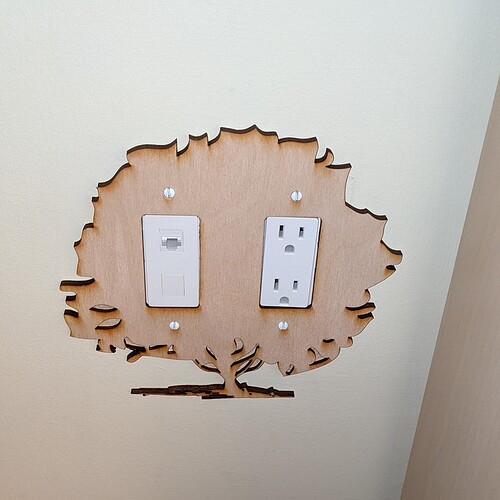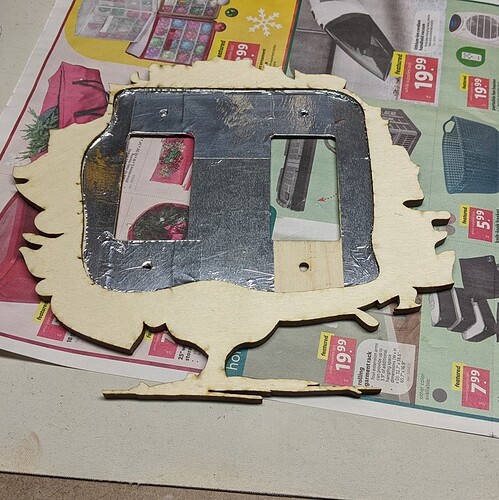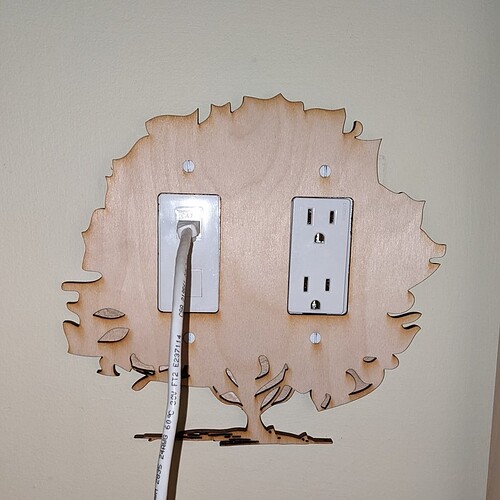Hey folks! I have project pics and a funny story.
Pic first! Behold the Tree of Knowledge and Power, a custom two-gang decora plate cover for a cat 6 internet jack and a standard outlet:
I used @cynd11’s Light Switch Cover Design Files for the decora and screw cutouts (decora is the type of plate with the big rectangle in the middle). I increased the width of the decora cutouts by about a millimeter because the outlet is crooked.
Tree remixed from the Noun Project icon “Shrub” by Humberto Cesar Pornaro, CC-BY.
“Lovely,” you might think, “but why bother with such a design at knee height? Surely a normal plate cover would do?”
And now it’s story time, because here’s what happened:
I offered to help a friend fish cat 6 from their router to their office. I’m an electrician’s kid; I’ve been fishing wire since before I could spell fishing, wire, or “good grief why do I always forget how annoying fishing wire is!?”
The walls did not cooperate (they never do).
Several holes in drywall later, we finally found a wall that actually had open space in it, next to the outlet pictured above.
We promptly broke the drywall between our new cat 6 jack and the outlet:
Not wanting to have to patch drywall between or next to the boxes (because uuuuuuugh), I came up with the thrilling plan to make a custom plate cover. Nothing says “not to day, satan” like covering up your mess with plywood, am I right?
So we begin planning the cover.
My friend’s partner sees the planning and asks, in full innocence of the destruction we have wrought, “why are you making an outlet cover shaped like a tree?”
Me: “it is a tree of knowledge and power.”
My friend’s partner: …?
My friend: “Because it has the internet and an outlet.”
My friend’s partner: “Yeah no I get it but do you really need to go that hard at knee height?”
My friend: “We are dedicated to our craft.”
Me: “and to not patching drywall”
My friend’s partner: “what?”
Me: “what?”
So anyway I told this story on twitter and was told to come post it on the forums, so here is the very artistic cover that we were definitely planning on doing the whole time, and which exists only because it sparks joy and not because the wall behind it (and all the other walls in that room, why is there masonry inside interior walls, why I ask you, this house was built in the 1960s, what foolishness is this) sparks despair.
Some progress shots:
We printed a few paper fit tests, because nothing in this house of leaves is plumb. Here is one of them, pictured with the Human Digital Control tool we used to cut it after deciding we couldn’t be bothered to test paper cutting settings on the Glowforge:
Then we cut the front out of medium baltic birch. Here’s a final test fit, sans backing layer:
We used more paper tests to shape the backing layer, then lasered it and glued it on. The backing layer holds the plate flat against the wall. After it cured, we added aluminum tape as a spark barrier:
And the finished plate, in service:
The moral of this story is that you’re not in trouble if you put a hole in someone’s drywall. You’re only in trouble if you get caught.






